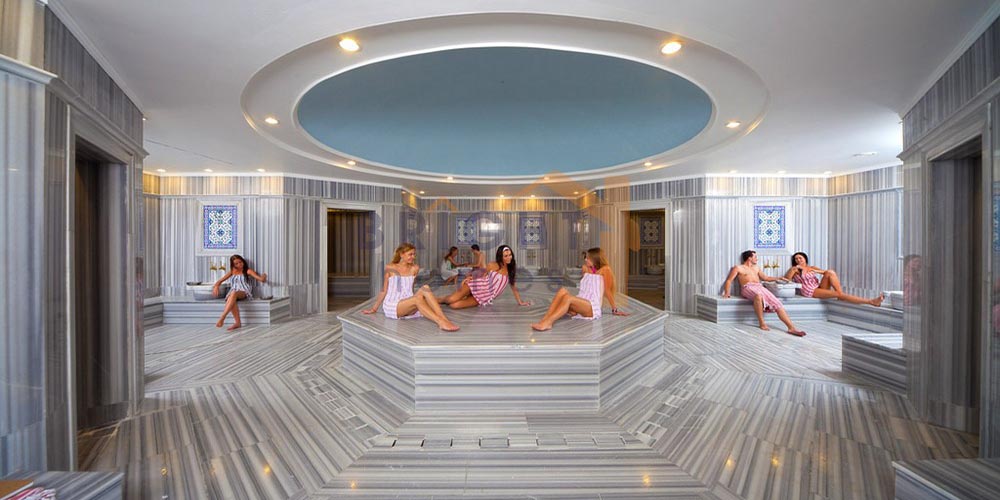Turkish Culture
Turkish bath – Hammam
Turks are a clean nation with their historical nobility. After the conquest of Istanbul, they built thousands of baths in this city and all over the State, as a result of their acceptance of Islam and their meticulous implementation of the purification provisions of Islam. In the seventeenth century, for example, there were 168 large bazaar baths in Istanbul alone.
How Was The Turkish Bath Born?
The tradition of hammam is a tradition that goes back to the Romans. Turks who came to Anatolia combined the bath tradition they brought with them with the Roman and Byzantine traditions. When the cleaning and hygiene rules ordered by Islam were added to this, the use of water and a new concept emerged: Turkish bath. The Turkish bath, which was initially a different type of bathroom, later gained institutionalism and created its own tradition. When the word Hamam, which means the place where the Turkish bath is washed, was added, the name of the Turkish bath changed to the Turkish bath. The first public bath in the public sphere was built in 1584 in III. Murat’s mother, Nurbanu Sultan, became the Çemberlitaş bath that Mimar Sinan had built. The number of baths increased in a short time. At the end of the 16th century, the number of baths in Istanbul was approaching five thousand, 300 of which were public and 4536 private.

Turkish baths are divided into three main parts:
1) Dressing places
2) Bathing places (Bathing places also a) Coldness b) Bath)
3) Heating place: Külhan
Dressing Places
There is a wide sofa and partitioned benches around it. People who have bathed lie down and rest on these benches.
Bathing Places
It is called the bath section that is entered through the cold. This is also some; divided into sections. “The place where everybody is washed one by one, called the kurna head, is the closed and solitary bathing cells called“ halvet ”. And also the “belly stone” on which sweat is poured. This is the place that is built higher than the marble floor of the bathhouse and can have various geometric shapes.

Heating place Külhan
This place is under the bath. The fire burns there. The flame and smoke coming out of the fire passes through special roads under the marble floor, through the walls, and comes out through the chimney called “tuteklik”.
There is a hot water boiler on the furnace in the furnace and a cold water tank on it. A few channels at the bottom of the stove extend under the umbilical stone in the middle of the bath’s washing area. The effective flames and fumes of the firewood burning in the stove go under the belly stone through these channels. Since the dark place under this stone gets very hot, it is called “hell”.

Bazaar baths are open to women on certain days of the week and to men on other days. The “double baths” are two adjacent baths, one for women and the other for men. These baths are open every day.
Istanbul’s baths are known all over the world. In terms of being old, Bayezit, Çemberlitaş, Hoca Pasha, Fındıklı baths, Mehmedağa bath in Fatih, etc. has. In addition, there were also baths that could not stand the destruction over time and were destroyed. Especially almost none of the famous mansion baths have survived today. Only Palace baths (Topkapı and Dolmabahçe) decorate Istanbul today, as an example of architectural monuments of different eras. Furthermore, the City’s famous thermal baths with natural hot sulfur water, Gonen Turkey’s thermal baths and spas and are scattered around the normal baths.
Another different aspect of Turkish baths is that they are “Finnish baths” based on steam bath. Finns are originally of Turkish origin. Today, in the world of sports, these baths are ideal for sweating quickly and losing a lot of weight. In this respect, all athletes benefit from Turkish baths.
Health Benefits of Turkish Baths
Baths are the best bathing and cleansing places for body cleansing with hot water and soap, provided that it does not stay for too long. In the hammam, washing the sweaty body by rubbing it with a soft cloth or sponge facilitates blood circulation in the body and gives people comfort. Rubbing the body with hard washcloths can cause skin wounds. This should be avoided. Also, those who take a bath in baths must follow the rules of manners. In addition, staying in baths too much, going from hot to cold, from cold to hot from time to time can be harmful to the body. It is dangerous to bathe in very hot water for people with high blood pressure and those with pulmonary tuberculosis with impaired heart and circulatory system. Because staying in very hot water for a long time causes blood to attack the brain and lung bleeding in TB patients. In addition, those who cannot take care of themselves after the bath and catch a cold also suffer from pneumonia. As you pay attention, baths are not harmful and they are very useful.

